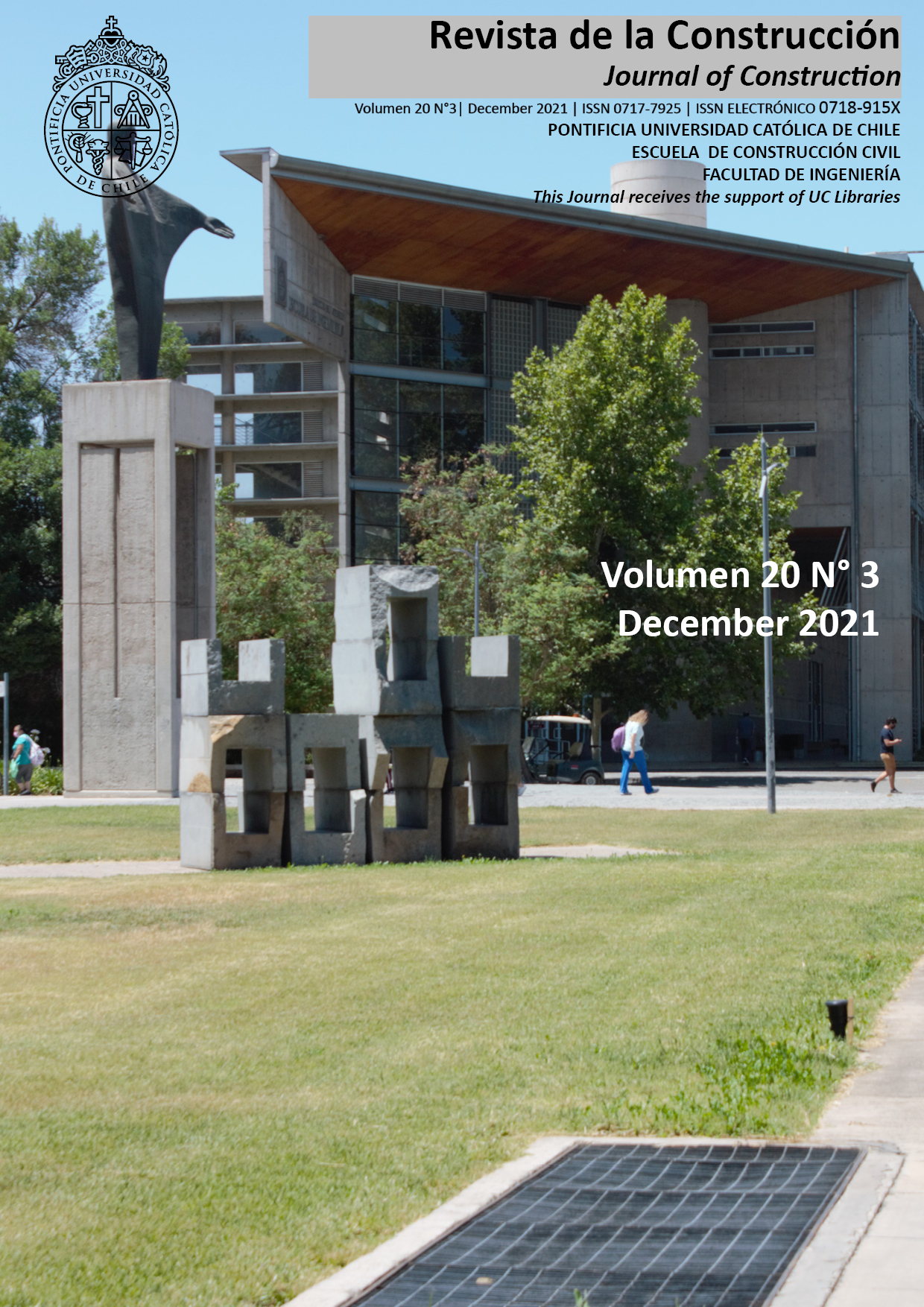Numerical investigation of the effect of beam slab openings in RC structures on seismic behavior
DOI:
https://doi.org/10.7764/RDLC.20.3.512Keywords:
finite element method, seismic effect, slab discontinuities, diaphragm behavior, reinforced frame systemAbstract
Earthquake negatively affects the behavior of reinforced concrete frame systems that have slab discontinuities. As a result of differences in diaphragm behavior according to slab void ratio and position, lateral loads cannot be distributed to vertical bearing elements in proportion to their rigidity. In this study, the topic of differences in the behavior of reinforced concrete frame system under lateral load if void ratio and position of the slab change have been examined numerically. For this purpose, five single-story three-dimensional carrier frame models with different void ratios and positions were created in the ANSYS program analyzing according to the finite element method. As a result of the study, an increase in slab void ratio of reinforced concrete frame type carrier systems resulted in displacement in more significant amounts. Along with 25% being a safe void ratio in terms of rigid diaphragm behavior when the void ratio is 50%, whether the void is symmetrical or not becomes extremely important in terms of behavior.
Downloads
References
Ansys Inc. (2013). mechanical user’s guide. ANSYS.
Arslan, S. (2007). Effects of the slab discontinuties on structural systems behavior in reinforcement buildings (Institute of Science and Technology). Institute of Science and Technology. Retrieved from https://polen.itu.edu.tr/handle/11527/6840
Bastos Martinelli, L., & Cassimiro Alves, É. (2020). Analysis of damping ratio on the optimization of geometrically nonlinear truss structures subjected to dynamic loading. Revista de La Construcción. Journal of Construction, 19(3), 321–334. https://doi.org/10.7764/RDLC.19.3.321
Çelik, A. İ. (2019). Step by Step Finite Element Method with ANSYS Workbench (1st ed.; L. Gemi & Y. O. Özkılıç, Eds.). Ankara: Nobel Bilimsel Eserler. Retrieved from www.nobelkitap.com
Çelik, A. İ. (2020). ANSYS WorkBench ile MEKANİK (1st ed.). Ankara: Nobel Bilimsel Eserler. Retrieved from www.nobelkitap.com
Eurocode-8, C. (2005). CEN (European Committee for Standardization). (2005).
Fleischman, R. B., & Farrow, K. T. (2001). Dynamic behavior of perimeter lateral-system structures with flexible diaphragms. Earthquake Engineering & Structural Dynamics, 30(5), 745–763. https://doi.org/10.1002/eqe.36
Harris, H., & Sabnis, G. (1999). Structural modeling and experimental techniques. Retrieved from https://books.google.com/books?hl=tr&lr=&id=_PQlsAnCQxcC&oi=fnd&pg=IA5&dq=Harris+HG.+and+Sabnis,+G.+(1999).+&ots=_Ns0iAY4R7&sig=mRH52fUAeCdOC649a4-OtaNXVIQ
IAEE. (2000). International Association for Earthquake Engineering. Retrieved February 4, 2021, from https://www.iaee.or.jp/worldlist.html
IBC. (2009). International Building Code.
Ju, S. H., & Lin, M. C. (1999). Comparison of Building Analyses Assuming Rigid or Flexible Floors. Journal of Structural Engineering, 125(1), 25–31. https://doi.org/10.1061/(ASCE)0733-9445(1999)125:1(25)
Keyvani, S., & Hoseini Vaez, S. R. (2019). Using DLO procedure to investigate the effect of openings on ultimate load and collapse pattern of slabs. Structures, 20, 717–727. https://doi.org/10.1016/J.ISTRUC.2019.06.023
Khajehdehi, R., & Panahshahi, N. (2016). Effect of openings on in-plane structural behavior of reinforced concrete floor slabs. Journal of Building Engi-neering, 7, 1–11. https://doi.org/10.1016/j.jobe.2016.04.011
Kunnath, S. K., Panahshahi, N., & Reinhorn, A. M. (1991). Seismic Response of RC Buildings with Inelastic Floor Diaphragms. Journal of Structural Engineering, 117(4), 1218–1237. https://doi.org/10.1061/(ASCE)0733-9445(1991)117:4(1218)
Özbayrak, A. (2017). Özbayrak, A. (2017). Investigation of the effect... - Google Akademik. Retrieved February 4, 2021.
Özbayrak, A., & Altun, F. (2020). Torsional effect of relation between mass and stiffness center locations and diaphragm characteristics in RC structures. Bulletin of Earthquake Engineering, 18(4). https://doi.org/10.1007/s10518-019-00744-8
Özbayrak, A., & Altun, F. (2021). Experimental study of the effects of slab openings on seismic behaviour of buildings. European Journal of Environmen-tal and Civil Engineering, 1–21. https://doi.org/10.1080/19648189.2020.1868342
Özsoy, İ., & Kuyucular, A. (2003). Influence of slab openings on floor displacements of reinforced concrete buildings beamed. Retrieved from https://www.imo.org.tr/resimler/ekutuphane/pdf/10128.pdf
Öztürk, T. (2013). Öztürk, T. (2013). Effect of openings in building... - Google Akademik. Retrieved February 4, 2021, from https://scholar.google.com/scholar?hl=tr&as_sdt=0%2C5&q=Öztürk%2C+T.+%282013%29.+Effect+of+openings+in+building+slabs+on+the+structural+system+behavior%2C+Journal+of+IMO%2C+393%2C+6233-6256.&btnG=
Saffarini, H. S., & Qudaimat, M. M. (1992). In‐Plane Floor Deformations in RC Structures. Journal of Structural Engineering, 118(11), 3089–3102. https://doi.org/10.1061/(asce)0733-9445(1992)118:11(3089)
Sağlıyan, S., & Yön, B. (2018). Assessment of Earthquake Behavior of Reinforced Concrete Buildings with Slab Discontinuity. Turkish Journal of Science & Technology, 13(1), 87–92.
TBEC. (2018). TBEC (Turkish Buildings Earthquake Code). (2018).... - Google Akademik. Retrieved February 4, 2021, from
Timoshenko, S. P., & Woinowsky-Krieger, S. (1959). Theory of plates and shells. McGraw-hill: McGraw-hill.
Timoshenko, S. P. and Goodier, J. N. (1970). Timoshenko, S. P. and Goodier, J. N. (1970). Theory... - Google Akademik.
TS500. (2000). TS500 (Turkish Standards Institute). (2000). Google Akademik. Retrieved February 4, 2021.
Ugural, A. (1999). Stresses in plates and shells. Retrieved from https://cds.cern.ch/record/465975
Verderame, G. M., De Risi, M. T., & Ricci, P. (2018). Experimental Investigation of Exterior Unreinforced Beam-Column Joints with Plain and Deformed Bars. Journal of Earthquake Engineering, 22(3), 404–434. https://doi.org/10.1080/13632469.2016.1233917
Volterra, E. and Gaines, J. H. (1971). Volterra, E. and Gaines, J. H. (1971). Advanced strength.
Yön, B., Öncü, M., & Of, Z. U. (2010). Investigation of Effect of Slab Opening Location to the Shear Stress. Pamukkale University Journal.








